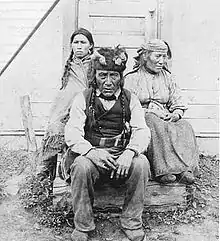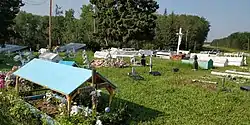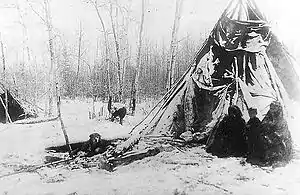Dane-zaa
The Dane-zaa (ᑕᓀᖚ, also spelled Dunne-za, or Tsattine), historically referred to as the Beaver tribe by Europeans, are an Athabaskan-speaking group of First Nations people. Their traditional territory is around the Peace River in Alberta and British Columbia, Canada. Today, about 1,000 Dane-zaa reside in British Columbia and a hypothesized half of them speak the Dane-zaa language. Approximately 2,000 Dane-zaa live in Alberta.
ᑕᓀᖚ | |
|---|---|
 | |
| Total population | |
| 1,700[1] (2016 census) | |
| Regions with significant populations | |
| Canada | |
| British Columbia | 890 |
| Alberta | 770 |
| Languages | |
| English, Dane-zaa | |
| Religion | |
| Christianity, Animism | |
| Related ethnic groups | |
| Tsuu T'ina | |
Name
The name Dunne-za has been translated to "Those who live among the beaver." The spelling Dane-zaa is typically used for "the Real People." That spelling is used by the Dane-zaa Language Authority.[2] Different tribes and First Nations use different spellings. For example, the Doig River First Nation (DRFN) and Halfway River First Nation (HRFN) use Dane-Zaa. Prophet River First Nation (PRFN) uses Dunne Tsaa; and the West Moberly First Nations (WMFNs) use Dunne-za or Dunne Za. Where other spellings are used in citations, such as Dunne-Za (e.g., Ridington 1988), they are kept intact and are synonymous with Dane-zaa.
The historic usual English term Beaver is a translation of the name used by several of their neighboring tribes. The Dakelh called them Tsattine / Tsat'en and the Plains Cree called them Amiskiwiyiniw, both meaning "Those who live among the beaver" or "Beaver People." In French, they are known as the Gens de Castor, meaning "People of the Beaver".
History

Prior to the 19th century, the Dane-zaa inhabited lands further east, near the Athabaska and Clearwater Rivers, and north to Lake Athabaska, as well as territory north of the upper Peace River (called Saaghii Naachii, meaning "big river," by them). Archaeological evidence at Charlie Lake Cave establishes that the area of Charlie Lake north of Fort St John has been continuously occupied for 10,500 years by varying cultures of indigenous peoples.
In the late 18th century, European-Canadians opened the Peace River area to fur trading. Scot-Canadian explorer Alexander Mackenzie (explorer) established Rocky Mountain Fort at the mouth of the Moberly River in 1794.
According to Dane-zaa oral history, the Peace River is named for the settling of a conflict between the Dane-zaa and the Cree. The Cree traditionally lived south and east of the Upper Peace River region. Due to their trade with settlers, they had guns and they pushed the Dane-zaa northwest in the late 18th century. A peace treaty, negotiated in the late 1700s or early 1800s, stated that the Cree would live south of the Peace River, and the Dane-zaa north.[3] The Peace River, before and after its new name, marked a boundary zone, where groups met for trade, celebration, and settling of disputes.
A post journal of 1799–1800 mentions people trading at the post who can be identified as the ancestors of members of the former Fort St John Band, now the Doig River and Blueberry River First Nations. Doing oral history confirms that the ancestors of present Dane-zaa families were in the upper Peace River area prior to the first contact by Alexander Mackenzie in 1793. Traders provisioned their expeditions with bison meat and grease provided by the Dane-zaa in their hunting on the rich prairies of the upper Peace River area. By the time the Hudson's Bay Company took over the North West Company in 1823, bison were scarce.
Traditionally, Dane-zaa has followed the teachings and songs of Dreamers, who first predicted the coming of the Europeans. The last Dreamer, Charlie Yahey, died in 1976.
The Dane-zaa of Fort St John took an adhesion to Treaty 8 in 1900. Today they continue to have a strong cultural and economic presence in the North Peace area.

In collaboration with the elders of the Doig River First Nation, Robin and Jillian Ridington wrote Where Happiness Dwells: A History of the Dane-zaa First Nations, which was published by UBC Press in 2013. It features the oral history of the Dane-zaa from pre-history to the present day.[4]
Dreamers
Dreamers, called Naachin,[5] hold an important role in the Dane-zaa community. They have been important to the Dane-zaa since before colonization, and are both men and women. They are able to have out-of-body journeys to visit with the ancestors in order to guide their community. They are able to dream the future and help the Dane-zaa live in the changing world, and many Dreamers predicted the arrival of Europeans.[6] Seen to be like Swans, they are able to "fly" from their physical bodies and follow a trail to heaven called yaak'ihts'ęʔ atanii in dreams and are able to bring dreams from this otherworldly place back to the community.[7] With this gift, they teach their people to live in peace with the world around them.[8] Through these dream journeys, they make sure the Dane-zaa know to sing and dance to uphold normal relationship to nature and for the celestial cycles to continue. They believe that song and dance is vital in understanding the Dane-zaa identity and experience with the world, and that songs are the trails they need to find meaning in the world around them.[9] While the Dane-zaa believe that some individuals hold this special power and dream for the community, they also acknowledge that everyone is capable of having the gift of prophetic dreams.[10]
Danezaa governments

Treaty 8 Tribal Association
Treaty 8 Tribal Association members:[11]
- Doig River First Nation[12] (Dane-Za Adishtl'sh, takes its name from the Doig River (Hanás̱ Saahgéʔ) running through the reserve and has strong ties with the Blueberry River First Nation, band office is on the most populous reserve Blueberry River IR No. 206, Reserves: Beaton River IR No. 204 (North Half), Doig River IR No. 206, Population: 301)
- Blueberry River First Nations (was given this name because of the abundant supply of blueberries found in the river valley, band office is on the most populous reserve IR No. 205, about 80 km northwest of Fort St. John, Danezaa and Cree, Reserves: Beaton River No. 204 (South Half), Blueberry River IR No. 205, Population: 472)
- Halfway River First Nation[13] (originally from Chowade River (Stony River) it was the last First Nation to move to its new location in the early sixties. Once forming with the West Moberly First Nation the Hudson Hope Band, the First Nations separated in 1971, the community is located 75 km northwest of Fort St. John, Reserve: Halfway River IR No. 168, Population: 268)
- Prophet River First Nation (Dene Tsaa First Nation, the First Nation is located 100 km south of Fort Nelson, Reserve: Prophet River IR No. 4, Population: 266)
- Saulteau First Nations[14] (In the 1870s one group of Anishnaube (Saulteau) migrated westward from Manitoba and settled at Moberly Lake, where they later intermarried with the Nēhiyawēwin (Cree) and Danezaa (Beaver) who were already living in the area, the community is located at the east end of Moberly Lake, about 100 km southwest of Fort St. John, Reserve: East Moberly Lake IR No. 169, Population: 840)
- West Moberly First Nations (was originally part of the Hudson Hope Band, which split into West Moberly and Halfway River First Nations in 1971, the community is located at the west end of Moberly Lake, about 90 km southwest of Fort St. John, Danezaa and Cree, Reserve: West Moberly Lake No. 168A, Population: 275)
North Peace Tribal Council (NPTC)
North Peace Tribal Council members:[15]
- Beaver First Nation has two reserves are both near Fort Vermilion, Alberta in the Peace Country of Northern Alberta, band office is on the most populous Reserve Beaver IR No. 164A, Reserves: Boyer IR No. 164 (Rocky Lane), Child Lake IR No. 164A (Eleske), Population: 1 027)
Western Cree Tribal Council
- Horse Lake First Nation is a First Nation headquartered in Hythe, Alberta. It is a party to Treaty 8, and despite being a member of the Western Cree Tribal Council, the Horse Lake nation is linguistically and culturally a part of the Danezaa or "Beavers". Reserves: Clear Hills IR No. 152C, Horse Lakes IR No. 152B, Population: 1 089)[16]
References
- "Aboriginal Ancestry Responses (73), Single and Multiple Aboriginal Responses (4), Residence on or off reserve (3), Residence inside or outside Inuit Nunangat (7), Age (8A) and Sex (3) for the Population in Private Households of Canada, Provinces and Territories, 2016 Census - 25% Sample Data". www12.statcan.gc.ca. Government of Canada. Retrieved 2017-11-23.
- Dane-zaa Language Authority, Shona Nelson, October 3, 2012).
- Chillborne Environmental 2009
- Ridington, Robin and Jillian Ridington. 2013. Vancouver, UBC Press.
- Ridington and Ridington, Robin and Jillian (2006). When You Sing It Now, Just Like New: First Nations Poetics, Voices, and Representations. Lincoln: University of Nebraska Press. p. 172. ISBN 0803290098.
- Ridington and Ridington, Robin and Jillian (2013). Where Happiness Dwells: A History of the Dane-zaa First Nations. Vancouver: UBC Press. p. 9. ISBN 9780774822954.
- Ridington and Ridington, Robin and Jillian (2013). Where Happiness Dwells: A History of the Dane-zaa First Nations. Vancouver: UBC Press. p. 26. ISBN 9780774822954.
- Ridington and Ridington, Robin and Jillian (2013). Where Happiness Dwells: A History of the Dane-zaa First Nations. Vancouver: UBC Press. p. 157. ISBN 9780774822954.
- Ridington and Ridington, Robin and Jillian (2006). When You Sing It Now, Just Like New: First Nations Poetics, Voices, and Representations. Lincoln: University of Nebraska Press. pp. 172–173. ISBN 0803290098.
- Ridington and Ridington, Robin and Jillian (2006). When You Sing It Now, Just Like New: First Nations Poetics, Voices, and Representations. Lincoln: University of Nebraska Press. p. 233. ISBN 0803290098.
- Treaty 8 Tribal Association Communities Archived 2011-10-03 at the Wayback Machine
- Doig River First Nation Archived 2007-06-07 at the Wayback Machine
- Halfway River First Nation Archived 2011-11-10 at the Wayback Machine
- Saulteau First Nations Archived 2012-03-20 at the Wayback Machine
- North Peace Tribal Council (NPTC) Archived 2011-08-15 at the Wayback Machine
- "Archived copy" (PDF). Archived from the original (PDF) on 2013-05-12. Retrieved 2012-11-05.CS1 maint: archived copy as title (link)